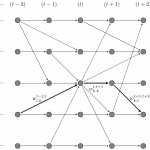- The Value of Contractual Commitments in Robust Supply Chain Network Design
- Equity in the Facility Location Problem
- Two-stage nodal network interdiction under decision-dependent uncertainty
Abstract: This study aims to develop a fortification plan for protecting infrastructure from intentional attacks, using a trilevel robust shortest path problem based on a defender-attacker-defender model. The plan involves identifying weaknesses, attacking non-fortified components, and determining the shortest path between the source and sink of the interdicted network.
- The high-risk zones shown on the map of Istanbul.
- Network topology of the high-risk zones
- A grid 3*4 network
Abstract:Developing responsive line plans for urban transportation systems is crucial to address the high level of variation and fluctuation in demand over time and space. A multi-period line planning approach that considers changing demand and allows for dynamic transfer of resources can lead to more feasible and cost-effective solutions, as demonstrated through a mathematical modelling framework using real-life data.
- Average weekday demand in Metrobüs system.
- Network map of Metrobüs system with terminals and lines.
- Resource transition between periods and lines.
Abstract: This study combines the European Foundation of Quality Management (EFQM) model and Quality function deployment (QFD) to evaluate a Project management system (PMS) in an aviation organization. Although the integration of these models increases system complexity, it helps identify all noteworthy success factors of PMS within the organization and evaluate its performance. The study aims to find out how organizations can effectively manage PMS tools and uses a comprehensive questionnaire to identify critical success factors in an aviation organization with multiple management departments.








